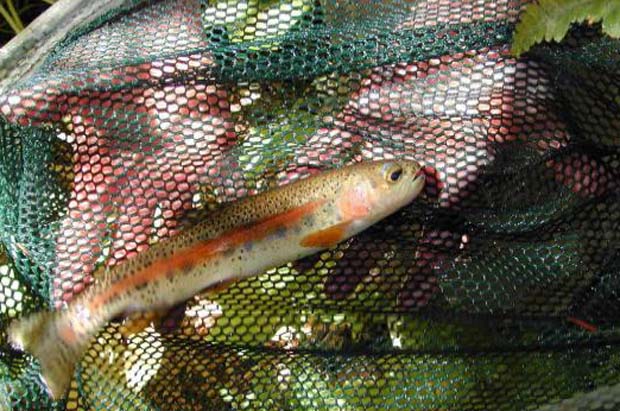Silver Creek is currently experiencing record low flows, high water temperatures and low dissolved oxygen levels. In an effort to reduce stress on the fishery at the preserve, The Nature Conservancy is temporarily restricting access to Silver Creek for fishing. For more information go to this link. Coincidentally, the following blog was written prior to these temporary restrictions. 
NOTE: Silver Creek is in southern Idaho – the product of two merging steams. One the spring-fed tributary of the Little Wood, and the other a tributary of the Middle Fork of the Payette River.
Where have all the trout gone?
By Bob Unnasch, director of science / Friday, July 25, 2014
[dropcap]I[/dropcap]recently realized that I’ve been flyfishing for a half a century. A long time, for sure. For someone who has some trouble sitting still, I find flyfishing a great combination of adventure and relaxation. So, I look for opportunities to fish wherever I am. And, I look for interesting places to fish whenever I can. I caught my share of 3-inch bluegill from tiny creeks in Virginia, a 20-pound bluefish from the Atlantic Ocean, and last month was casting to 6-foot “high and happy” tarpon while neck-deep in the Gulf of Mexico.
Idaho is a wonderful place to be a fly fisherman. We have world-famous streams like Silver Creek and the Henrys Fork. But, we also have thousands of miles of streams harboring small trout that enthusiastically take a fly. I spend a lot of time wandering around, testing these smaller waters with a small fly rod.
Every spring I make forays into the Owyhee Canyonlands looking for desert trout. The Columbian Red-band Trout is Idaho’s native rainbow trout. At one time, it was found throughout the Columbia River basin. Unfortunately, it has been largely displaced by a different strain, the McCloud River rainbow. McCloud River rainbows are the favored trout to grow in hatcheries, and so have been introduced into rivers and streams worldwide. Redbands are unique in that they are able to tolerate warmer water than other trout – at least for short periods. But, they remain trout, and need cold water to thrive.
Most Idaho fishermen think of Redbands as tiny little fish, but under the right circumstances they can grow to be over 20-inches long. Which brings me back to my hikes into the Owyhees. I’ve discovered some places that have big naïve Redband trout. How better to enjoy a spring weekend than to be in the desert catching big trout? Early this past May, my son and I spent a weekend at one of my favorite desert streams expecting to catch some of those big Redbands. And, nothing. We didn’t catch any fish, which isn’t all that surprising. But, we didn’t see any fish either. This is a stream that, in past years, would have dozens of feeding trout per mile in May. We walked and walked and looked and looked. No fish.
This got me to wondering what happened. Where have all the trout gone? The water temperature was perfect for trout, 54 degreesF. But, the water temperature isn’t always that cold in these desert streams. During the summer months streamflows decline and the water warms up. The Redband trout then retreat to deep, spring-fed pools where they sustain themselves in these little pockets of cold water.

Although this is a CA McCloud strain, this what Redband Trout look like. Photo Credit: Mike Dean, Calfornia Dept of Fish & Game.
Recall that last summer was hot. All summer. The daily average temperature in Boise last July was 93 degreesF, more than 5 degreesF above normal. This heat wave was reflected in our river’s temperatures. On July 2, the water temperature in the Owyhee River reached 82 degreesF. The river’s daily high exceeded 80 degreesF from July 17 to July 27. The lethal temperature for rainbow trout is 77 degreesF. Where had all the Redband trout gone? I fear they died during the heat wave last July. I wonder how many other streams may have lost native fish at the same time. As I write this the stifling hot second week of July, it seems 2014 will be a repeat of last year.
To read complete story, click here . . .







